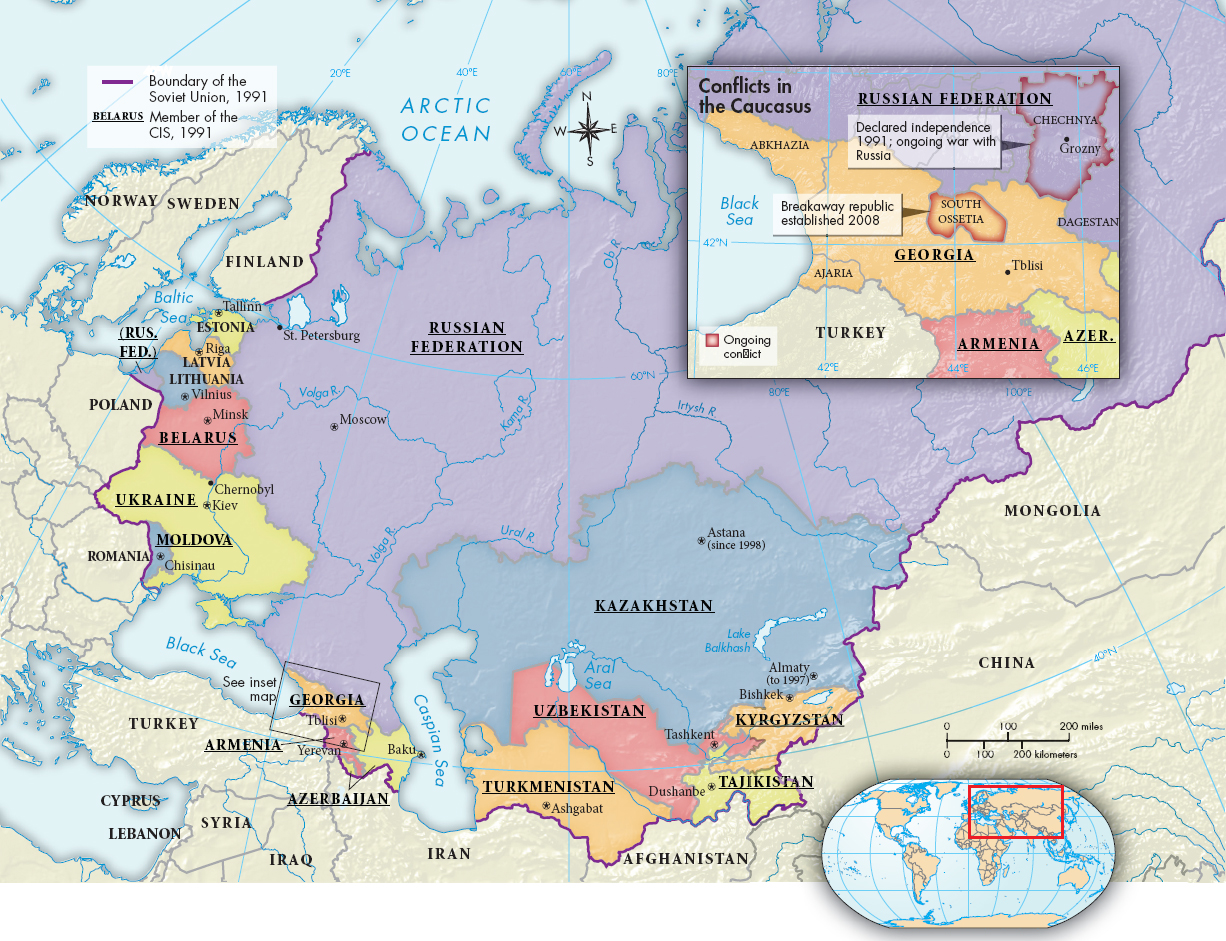Russian Revival Under Vladimir Putin
This widespread disillusionment set the stage for the “managed democracy” of Vladimir Putin (POO-tihn) (b. 1952). First elected president as Yeltsin’s chosen successor in 2000, Putin won re-election in a landslide in March 2004, and, after a four-year stint as prime minister, returned to the presidency in 2012. An officer in the secret police in the Communist era, Putin maintained relatively liberal economic policies but re-established semi-authoritarian political rule. Putin clamped down on the excesses of the Oligarchs, lowered corporate and business taxes, and re-established some government control over key industries.
This combination of autocratic politics and economic reform — aided greatly by high world prices for oil and natural gas, Russia’s most important exports — led to a decade of strong economic growth. In 2008, however, the global financial crisis and a rapid drop in the price of oil caused a downturn, and the Russian stock market collapsed. The government initiated a $200 billion rescue plan, and the economy stabilized and returned to modest growth in 2010.
During his first two terms as president, Putin’s domestic and foreign policies proved immensely popular with a majority of Russians. His housing, education, and health-care reforms significantly improved living standards. In foreign relations, Putin championed an assertive anti-Western Russian nationalism and regularly challenged U.S. and NATO foreign policy goals. In addition, the Russian president centralized power in the Kremlin, increased military spending, and expanded the secret police. Putin’s carefully crafted manly image and his forceful international diplomacy soothed the country’s injured pride and symbolized its national revival.
Putin and his United Russia Party moved decisively to limit political opposition. Though the Russian constitution guarantees freedom of the press, the government cracked down on the independent media. Using a variety of tactics, officials and pro-government businessmen influenced news reports and intimidated critical journalists.
Putin also took an aggressive and at times interventionist stance toward the Commonwealth of Independent States, a loose confederation of most of the former Soviet republics (Map 30.1). Since the breakup of the Soviet Union, Russian troops have repeatedly invaded Chechnya (CHEHCH-nyuh), a tiny Muslim republic with 1 million inhabitants on Russia’s southern border that declared its independence in 1991. Despite nominal Russian control over Chechnya, the cost of the conflict has been high. Thousands on both sides have lost their lives, and both sides have committed serious human rights abuses. Moscow declared an end to military operations in April 2009, but Chechen insurgents, inspired by nationalism and Islamic radicalism, continued to fight.

MAP 30.1
Russia and the Successor States, 1991–2010After the failure of an attempt in August 1991 to depose Gorbachev, an anticommunist revolution swept the Soviet Union. The republics that formed the Soviet Union each declared their sovereignty and independence, with Russia, under President Boris Yeltsin, being the largest. Eleven of the fifteen republics then formed a loose confederation called the Commonwealth of Independent States, but the integrated economy of the Soviet Union dissolved into separate national economies, each with its own goals and policies. Conflict continues to simmer over these goals and policies, as evidenced by the ongoing civil war in Chechnya and the conflict between Russia and Georgia over South Ossetia.
Russia also intervened in the independent state of Georgia. Russian troops invaded Georgia in 2008 to support a separatist movement in South Ossetia (ah-SEE-shuh), which eventually established a breakaway independent republic recognized only by Russia and a handful of small states.
Putin stepped down when his term limits expired in 2008. His handpicked successor, Dimitri Medvedev (mehd-VEHD-yehf) (b. 1965), easily won election that year and then appointed Putin prime minister, leading observers to believe that the former president was still the dominant figure. This suspicion was confirmed when Putin won the presidential election of March 2012 with over 60 percent of the vote. Some fifteen thousand protesters marched through downtown Moscow to protest election fraud and the authoritarian aspects of Putin’s rule, and demonstrations also accompanied the president’s inauguration that May.
